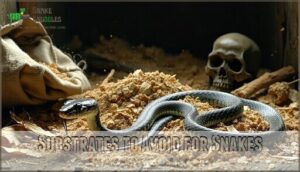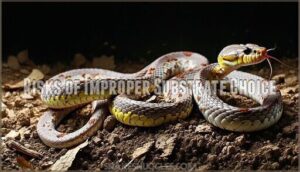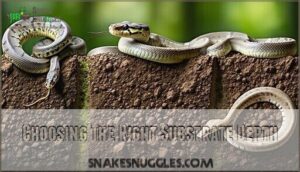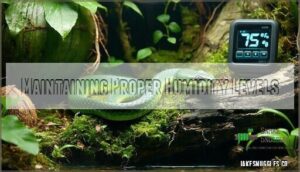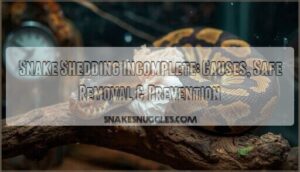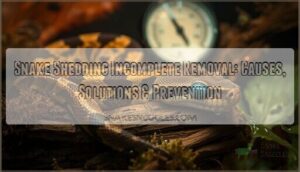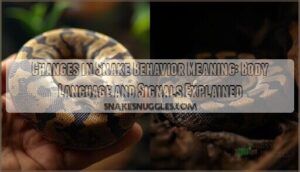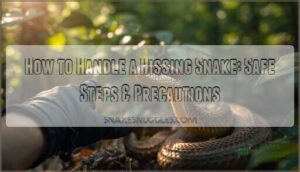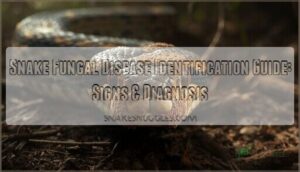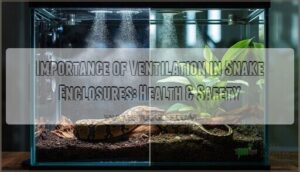This site is supported by our readers. We may earn a commission, at no cost to you, if you purchase through links.
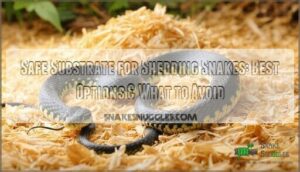
Aspen shavings work great – they’re absorbent, dust-free, and won’t stick to your snake’s skin. Coconut husk substrates like ReptiChip hold moisture well and create the humid environment shedding snakes need. Sphagnum moss is another solid choice that’s soft on sensitive skin.
Skip cedar, pine, or sand completely – they can cause respiratory issues or impaction. Your snake’s about to go through nature’s most vulnerable makeover, and the wrong substrate can turn shedding from smooth sailing into a nightmare scenario.
Table Of Contents
- Key Takeaways
- Safe Substrate Options
- Toxic Substrates Avoid
- Snake Cage Setup Tips
- Frequently Asked Questions (FAQs)
- What substrate is toxic to snakes?
- What bedding is safe for snakes?
- What should I put at the bottom of my snakes cage?
- What is the best flooring for snakes?
- How often should substrate be changed completely?
- Can shedding snakes eat while on substrate?
- What substrate temperature is ideal for shedding?
- Should substrate be misted during shedding cycles?
- Do different snake species need different substrates?
- Conclusion
Key Takeaways
- Choose proven safe substrates – Stick with aspen shavings, coconut husk, or sphagnum moss that will not harm your snake if accidentally ingested during feeding
- Avoid toxic materials completely – Never use cedar, pine, or sand substrates as they will cause respiratory issues, liver damage, or dangerous impaction
- Maintain proper humidity levels – Keep humidity at 70-80% during shedding (higher than the normal 50-70%) using moisture-retaining substrates and regular misting
- Use adequate substrate depth – Provide 2-4 inches of bedding to allow natural burrowing behavior and help create the humidity gradient your snake needs for successful shedding
Safe Substrate Options
Choosing the right substrate becomes essential when your snake enters its shedding cycle, as improper bedding can cause stuck shed and serious health problems.
You’ll want substrates that maintain proper humidity while staying safe if accidentally ingested during the vulnerable shedding process, which is a critical aspect of snake care.
1. Zoo Med Aspen Snake Bedding
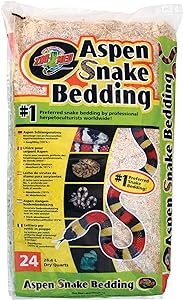
Zoo Med Aspen bedding delivers exceptional value for snake owners.
Professional herpetoculturists choose this renewable, odorless substrate for superior moisture control and natural burrowing support.
This renewable, odorless substrate excels at moisture control and prevents mold growth.
Its light color makes spot cleaning simple, while the perfect chunk size supports natural snake burrowing behavior.
Professional herpetoculturists prefer this cost-effective option.
At $11 for 24 quarts, it’s substantially cheaper than pet stores, making aspen bedding an economical choice for safe substrate needs, providing exceptional value.
2. ReptiChip Coconut Reptile Bedding Substrate
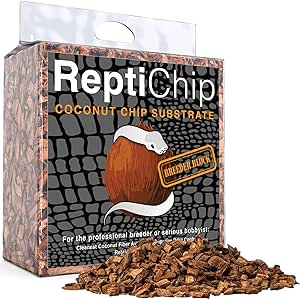
With exceptional humidity retention, ReptiChip coconut reptile substrate creates ideal conditions for snake shedding.
This compressed coconut fiber expands substantially, offering great cost analysis value.
The substrate supports natural snake burrowing behaviors while maintaining low dust content.
ReptiChip benefits include odor control and waste absorption, making it a safe substrate choice for reptile bedding needs.
For ideal humidity, remember to maintain levels between 60-80%.
3. Kritters Crumble Coconut Husk Reptile Bedding
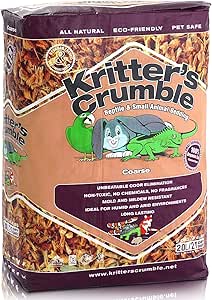
Versatility makes Kritters Crumble coconut husk reptile bedding a smart choice for snake shedding.
This coconut fiber substrate offers excellent humidity retention, helping your snake shed properly.
The crumble texture analysis shows it’s softer than chips, reducing injury risk.
Coconut husk benefits include natural odor control and biodegradability.
While Kritters Crumble cost runs higher than some reptile bedding alternatives, its moisture-holding properties make it worthwhile shedding aid, providing natural odor control.
Toxic Substrates Avoid
While many substrates work well for healthy snakes, certain materials can pose serious health risks during the vulnerable shedding period.
You’ll want to steer clear of substrates that can cause impaction, respiratory irritation, or create unsanitary conditions when your snake needs extra humidity and security, particularly those that can lead to respiratory issues.
Substrates to Avoid for Snakes
Cedar shavings and pine risks top the danger list for snake bedding.
These aromatic oils cause respiratory and liver damage.
Calcium sand creates deadly impaction when swallowed.
Dusty substrates irritate airways, while dustfree substrate options keep your snake healthy.
Avoid cat litter, walnut shells, and corncob bedding.
Choose nontoxic bedding for proper snake habitat safety.
Some examples include safe substrate alternatives.
Risks of Improper Substrate Choice
Wrong substrate choices can devastate your snake’s health.
Poor substrate choices can spell disaster for your snake’s health and wellbeing.
Poor snake bedding creates serious complications that affect shedding problems and overall snake health.
Choose dustfree substrate and nontoxic bedding to prevent these risks:
- Impaction Risk – ingesting inappropriate materials
- Respiratory Issues – from dusty substrates
- Scale Rot – excessive moisture retention
- Parasite Infestation – contaminated bedding sources
- Chemical Exposure – treated wood products
Snake Cage Setup Tips
Setting up your snake’s cage properly goes beyond just choosing safe substrate.
You’ll need to take into account substrate depth and humidity levels to create the perfect environment for successful shedding.
Choosing The Right Substrate Depth
Substrate depth affects your snake’s comfort and shedding success.
For most species, provide 2-4 inches of natural substrate.
Larger snakes need deeper bedding for burrowing depth and temperature regulation.
Small snakes require less but enough for moisture gradient creation.
Consider appropriate bedding depths for ideal snake health.
Absorbent bedding prevents shedding problems by maintaining proper humidity throughout your snake enclosure, supporting healthy reptile care practices, and ensuring proper humidity.
Maintaining Proper Humidity Levels
Your snake’s humidity needs jump during shedding periods, requiring 70-80% levels versus the usual 50-70%.
Monitor with digital hygrometers, mist natural substrate like coconut husk, and add large water bowls for evaporation.
Rough surfaces in the enclosure can also aid the shedding process.
Poor humidity control causes shedding problems, so balance moisture retention with proper enclosure ventilation to prevent hydration concerns while maintaining ideal reptile care conditions and ensuring a smooth shedding process with proper humidity control.
Frequently Asked Questions (FAQs)
What substrate is toxic to snakes?
Cedar shavings, pine bedding, and aromatic woods contain harmful oils that’ll irritate your snake’s respiratory system. Sand can cause impaction if ingested, while newspaper ink may contain toxins.
What bedding is safe for snakes?
Before telegraph wires carried news, you’d choose paper towels, newspaper, or aspen shavings for your snake’s home.
These materials won’t harm your pet during shedding, unlike cedar or pine which contain toxic oils.
What should I put at the bottom of my snakes cage?
Choose paper towels, cypress mulch, or aspen shavings for your snake’s enclosure bottom. These substrates absorb moisture, stay clean easily, and won’t cause impaction if accidentally eaten during feeding time.
What is the best flooring for snakes?
Paper towels work best for most snakes.
They’re absorbent, easy to clean, and let you monitor your snake’s health through droppings.
Cypress mulch and aspen shavings are solid alternatives that allow natural burrowing behaviors.
How often should substrate be changed completely?
You’ll want to completely replace substrate every 4-6 weeks, or sooner if it becomes heavily soiled, develops odors, or shows signs of mold growth affecting your pet’s health.
Can shedding snakes eat while on substrate?
Shedding snakes can eat while on substrate, but they typically won’t. Most snakes refuse food during shedding because their vision’s cloudy and they’re focused on the molt process instead.
What substrate temperature is ideal for shedding?
Ironically, you’d think snakes need heat lamps, but they don’t require specific substrate temperatures for shedding.
Room temperature around 70-80°F works fine, and your snake’s body heat and humidity matter more than warming the bedding itself.
Should substrate be misted during shedding cycles?
Lightly misting substrate during shedding helps maintain humidity levels, but don’t oversoak it.
You’ll want damp, not wet conditions – think of it like creating a gentle spa environment for your snake’s molt.
Do different snake species need different substrates?
Yes, different snake species definitely need different substrates.
Ball pythons thrive on cypress mulch or paper towels, while corn snakes prefer aspen shavings.
Desert species like sand boas need sand-based substrates, whereas tropical species require higher-humidity options.
Conclusion
Choosing the right safe substrate for shedding snakes isn’t rocket science, but it’s definitely snake science.
You’ve got solid options like aspen shavings, coconut husk, and sphagnum moss that’ll keep your slithery friend comfortable during this vulnerable time.
Skip the problematic substrates like cedar, pine, or sand that can cause serious health issues.
Remember, proper substrate depth and humidity levels make all the difference.
Your snake’s successful shed depends on these simple choices, so stick with proven safe substrates for shedding snakes.
- https://www.thecritterdepot.com/blogs/news/best-substrate-for-ball-pythons-and-other-common-snakes
- https://www.reddit.com/r/ballpython/comments/jbuj7u/is_it_normal_my_snake_is_shedding_in_flakes_and/
- https://www.newagepet.com/choosing-reptile-substrate/
- https://reptifiles.com/corn-snake-care-guide/corn-snake-substrate/
- https://cornsnake.net/pages/substrate

